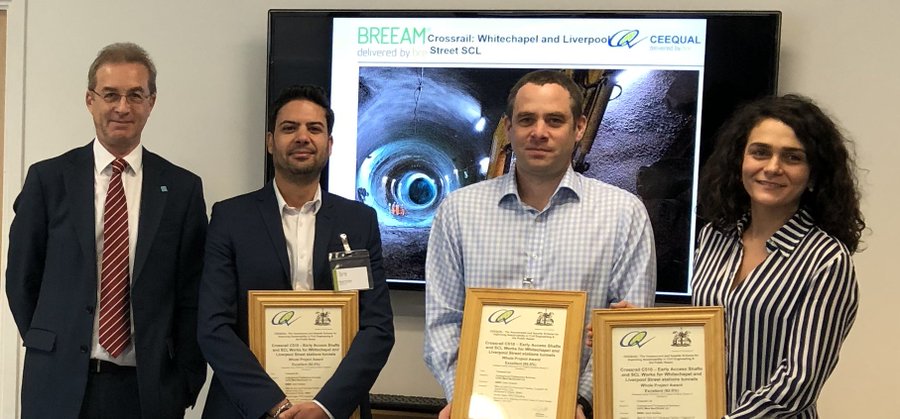CEEQUAL score of Excellent for Crossrail project in East London
Overview
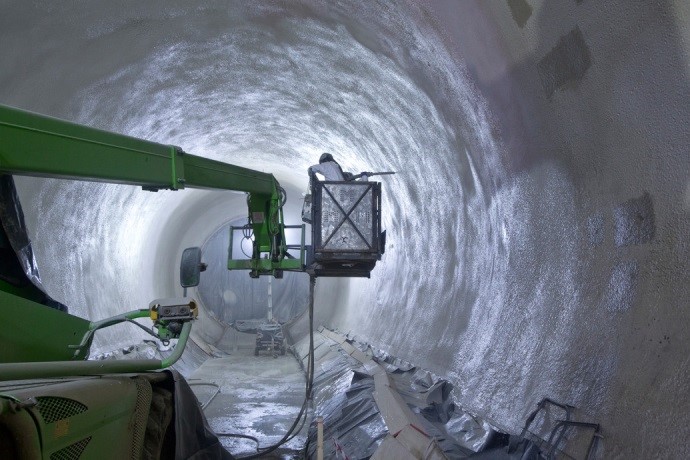
The major construction works for Crossrail C510, Whitechapel and Liverpool Street Station tunnels, began in April 2011. For its sustainable practices, the project was recognised with a Whole Team Award score of 92.5% - earning a CEEQUAL (now known as BREEAM Infrastructure) rating of ‘Excellent’.
About
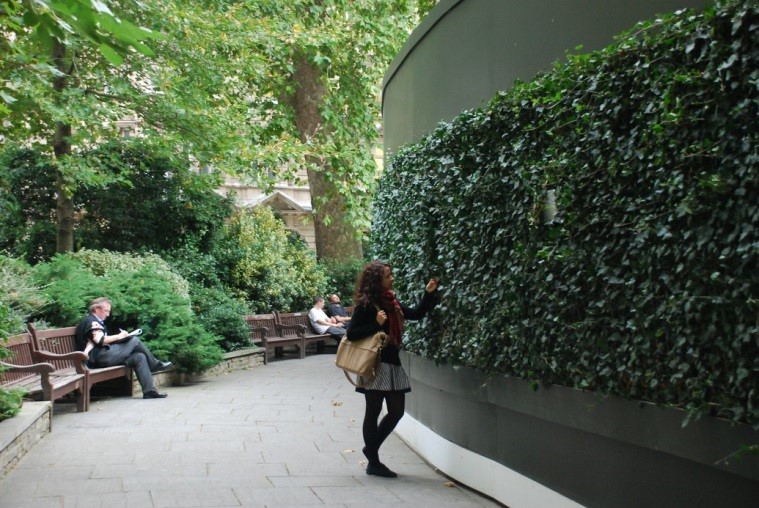
Crossrail is a railway construction project centred around London. Its aim is to provide rapid transport across the capital by connecting two major railway lines terminating in London.
Background
To complete this project, Crossrail was required to build 42km of tunnels, 10 new stations and improve 30 more. The finished railway, now known as the Elizabeth Line, is an accessible route of 41 stations from Reading and Heathrow in the west, to Shenfield and Abbey Wood in the east.
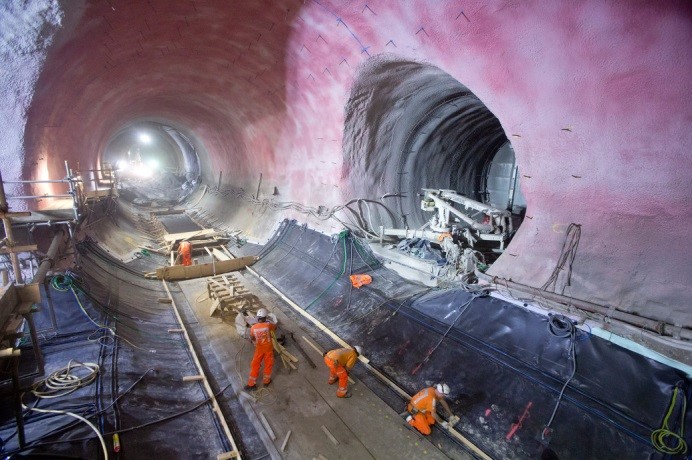
Challenges
This complex programme of works was undertaken over a six year period and was conducive to the successful delivery of the new railway. One of the biggest challenges was the construction of four compensation grouting sites in the vicinity of Liverpool Street station and one compensation grouting shaft in the vicinity of Whitechapel station.
Associated works included the shafts and adits, platform tunnels, Tunnel Boring Machine (TBM) reception chambers and launch chambers, cross passages, access passages, escalator barrels, ventilation ducts and a link passage from the new Liverpool Street station to the London Underground Northern Line Moorgate station platforms.
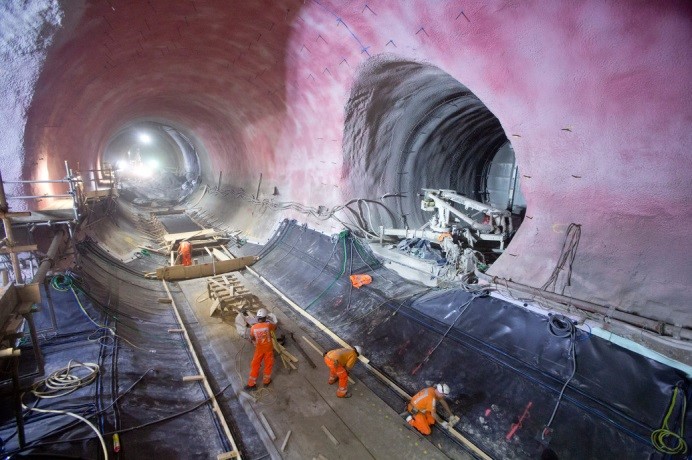
Solutions
Physical resources use and management
At BBMV’s Whitechapel site, the construction team applied innovative solutions to mitigate any delay to the Crossrail programme.
Bypass Tunnel
First was the construction of bypass tunnel, which linked Platform Tunnel West and the East Bound Running Tunnel (EBRT). This enabled construction of the EBRT at the same time as construction of the crossover. Then, 2no 2.0m diameter shafts were constructing to act as a secondary method to transfer materials to the tunnels beneath. This allowed BBMV to complete the secondary lining works in the western tunnels in parallel to the Crossrail C512 Whitechapel Main Station platform works.
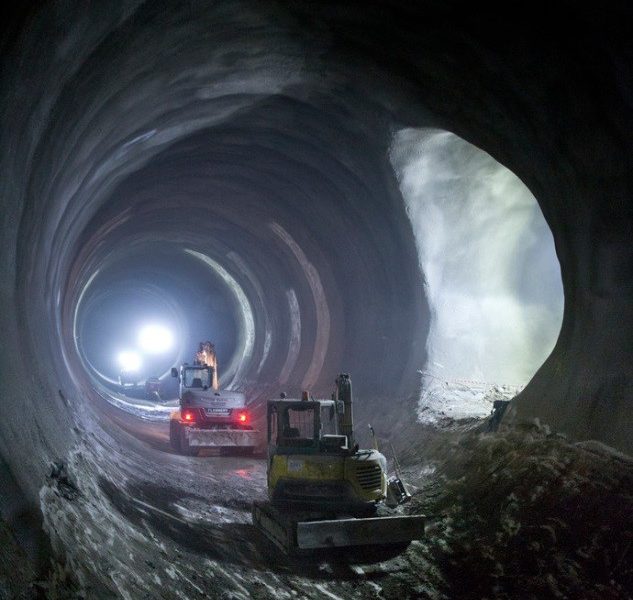
Backfilling voids with dammer
Construction took place in the midst of a highly dense urban environment, with residential properties located directly above the tunnel alignment, and adjacent to surface worksites. Backfilling the voids safely was the top priority as well as using an environmentally friendly material which would not impact negatively in the long term on the Chalk aquifer system in the London basin, while ensuring as little intrusion on the community as possible. The preferred material for such an activity is usually foam concrete. However, through research, the construction team came across a material widely used to backfill mining shafts and railway tunnels in Germany, Netherlands and Poland.
When compared, using the new material “Dämmer® – The Original” offered several advantages over using foam concrete. Delivery of the material used 15 lorry loads in total, taking 125 lorry movements off the road.
Applying the Dammer, did not require personnel being present below ground to monitor quality as the material is self-levelling and can be pumped direct down the shaft, making it the safest option. With 24.5% recycled content, the material is one of the few backfilling binders that are suitable for use in Water Protection Zones I and II. Its environmental compatibility was confirmed by the Hygiene-Institut des Ruhrgebiets (Hygiene Institute for the Ruhrgebiet). Commercially, this approach saved the project thousands in material costs.

Project and contract management
At Crossrail C510 Whitechapel and Liverpool Street Station Tunnels, the new platform tunnels are connected to the main station shafts by escalator shafts. The escalators are inclined at 30 degrees and constructed in London clay.
Traditional tunnelling techniques for excavating and lining these inclined tunnels would require access to the top of the escalator shaft for construction to proceed downhill. This is inherently safer than excavating the tunnel from the bottom-up.
Access to the main station shafts was projected to be delayed, so BBMV were required to come up with a solution. As an obvious alternative, massive temporary works access would be required to allow the excavation from the top but this would cause huge disruption to the adjoining contractors.
BBMV’s answer was to use the ‘Uphill Excavator’. Recognised as the only solution on the market which enables safe construction from low to high, the Uphill Excavator comprises an excavating and shotcrete spraying arm complete with operator’s cab that is suspended from the crown of the constructed tunnel and advances in line with tunnel progression.
A bespoke walkway running alongside the excavator provided the engineer with a safe location from which to carry out his work, while still being in visual and audible communication with the driver. The walkway also provided emergency egress for the operator at any point during the tunnelling operation.
The Uphill Excavator enabled BBMV to construct key connections much earlier than would have been possible with traditional downhill methods and also significantly improved safety for operators removing them from dangerous areas. The solution that BBMV proposed set them as innovators in the UK tunnelling industry as nothing like this has ever been undertaken before.

Noise and vibration management
Ground-borne noise and vibration (GBNV) and structure borne noise are common references to the sound field radiated by room surfaces due to excitation caused by often imperceptible magnitudes of vibration. This vibration can be caused by internal or external sources of vibration including underground railways and construction, or building services.
As a result of BBMV tunnelling works, this phenomenon caused some disturbance to some residents at properties next to the project and gave rise to ground-borne noise related complaints.
BBMV identified the immediate requirement for the development of an estimation tool to assist in pre-planning for, and managing, the future effects of ground-borne noise from these works. In the absence of any accepted prediction model for this type of application, the estimation tool has been developed from available empirical data gathered by BBMV during early SCL works in the Whitechapel area.
The available data was sourced from a number of surveys conducted in the neighbouring properties and is based upon a limited data set of 395 measurements. These measurements have been used to calibrate the existing site noise model, through an iterative process of testing and adjustment.
The surveys confirmed that the use of the hydraulic breaker below ground and in the tunnels during the SCL removal gave rise to significant levels of GBNV inside the nearest buildings to the tunnelling activity.
As a result, the engineers reviewed their work methods, re-designed the tunnel construction sequence, engaged directly with the residents and consequently implemented self-imposed working hours and operational constraints on the use of the hydraulic breaker.
In addition, BBMV pro-actively developed a dynamic GBNV management procedure, with a site specific management plan being prepared and updated on a monthly basis. This information was used to communicate likely periods of disturbance to the Local Authority and to Crossrail which in turn enabled any further control measures (including offers of temporary re-housing) to be identified.
This approach was recognised by Crossrail and was instrumental in BBMV achieving ‘World Class’ contractor status in Noise and Vibration Management, as verified in the Crossrail contractor review process (Supplier Performance League).
BBMV was able to demonstrate exceptional, outstanding and consistent performance across both sites with regards to:
Effective management of construction noise and vibration;
Communications and strong focus on external stakeholders and communities; &
Exceptional planning and early collaborative working with the construction team in order to reduce/prevent noise impacts before the start of and during execution of works.
Benefits
Crossrail’s Sustainability Strategy identified 18 key sustainability performance indicators designed to address the sustainability elements with the greatest relevance, impact, risk and opportunity for improvement. For example, reducing energy consumption, resource use in construction and whole life costs, and increasing local workforce employment and social inclusion.
The value of CEEQUAL in helping to keep focus on these areas of performance was identified by Crossrail early in the project and a commitment made to use this as an assessment methodology by utilising it from design through to construction.
While Crossrail’s Environmental Minimum Requirements (part of the Crossrail Act, 2008) set a high bar for environmental performance, the use of CEEQUAL ensured that aspects of performance that were not included in these key indicators were also considered throughout the process.
This allowed for incremental improvements to be made in several areas of project performance (e.g. opportunities to introduce new public amenity features into the project, consideration of end of life, factory application of coatings, and materials for permanent works).
The use of CEEQUAL also provided a good discipline in evidence collection which as assisted the overall contract closeout process.
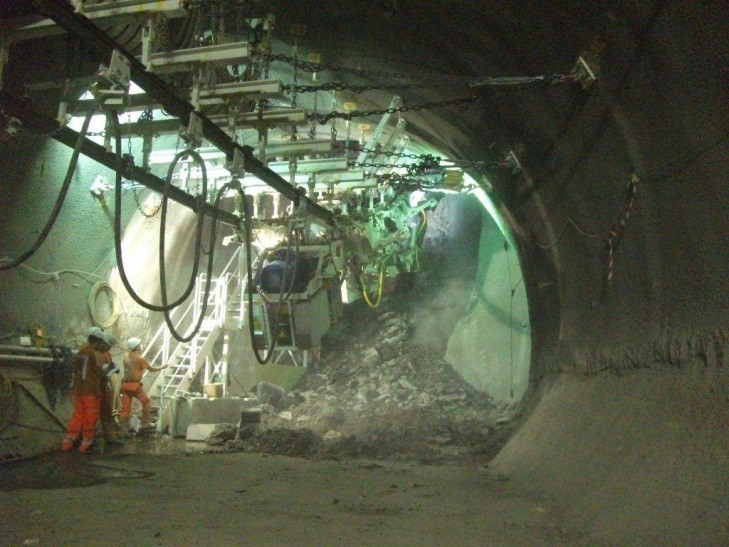
Benefit of using the Uphill Excavator
Reduced noise and vibration impact compared to traditional downhill tunnelling techniques
Increased construction efficiency for the delivery programme
Removed the excavation of these inclined tunnels from the project’s critical path, and released key interfaces between several contractors
Greatly reduced the safety risk and improved the interface between three different contracts, providing significant benefits to the entire Crossrail programme.
This approach was also recognised by the tunnelling industry with the following awards:
Product Design Innovation Award at The British Construction Industry Awards 2015;
Won both Technical Design of the Year and Product and Equipment of the Year awards at the NCE Tunnelling and Underground Space Awards 2015
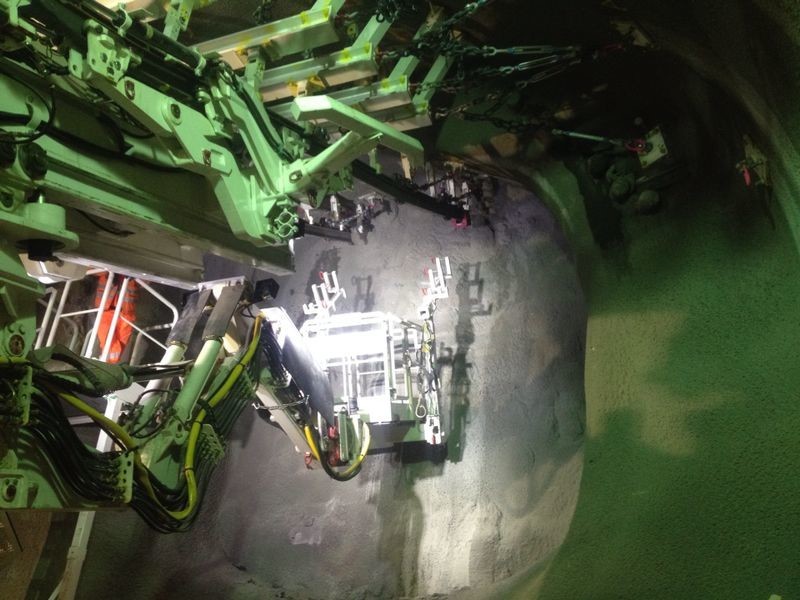
People and community
At the start of the four year contract for the Liverpool Street and Whitechapel platform tunnels contract, BBMV sought to set up a community investment plan that would not only benefit the local community during the period of construction, but leave a lasting legacy in the area for years to come.
In 2012, BBMV met with Providence Row, a homelessness charity in East London that tackles the root causes of homelessness, helping people get off and stay off the street. At the time, Providence Row was undergoing a change in approach, transforming not only what they did but also the way in which they did it. Central to this change was the ability to provide a safe and therapeutic environment for their clients.
Since then, BBMV has worked with the charity support this change, by transforming previously unused spaces within the Providence Row grounds into flourishing urban gardens. So far, BBMV has donated £40,000 to this vision and seen two phases of urban transformation completed; the previously derelict courtyard, which was converted into a colourful and welcoming urban garden in June of 2013; and the redevelopment of a previously unused roof area into a functional growing space, completed in 2015.
The urban gardens are now maintained by a weekly gardening group of Providence Row volunteers, and provide the charity’s clients with an opportunity to develop their horticultural and team working skills. Produce is grown on the rooftop garden, and is used by charity’s trainee catering scheme to cook breakfast for approximately 50 rough sleepers each morning. The gardens have also provided Providence Row with a location to hold community and fundraising events to gain further support for tackling the root causes of homelessness.
BBMV’s support, including corporate donations, staff fundraisers, donations of materials and volunteering days; has helped Providence Row employ a Garden Development Manager and Garden Designer to execute the delivery of the urban gardens.
BBMV continued to assist Providence Row into phase three of the green dream, on the upgrade of a public alleyway at the rear of the Charity’s grounds.
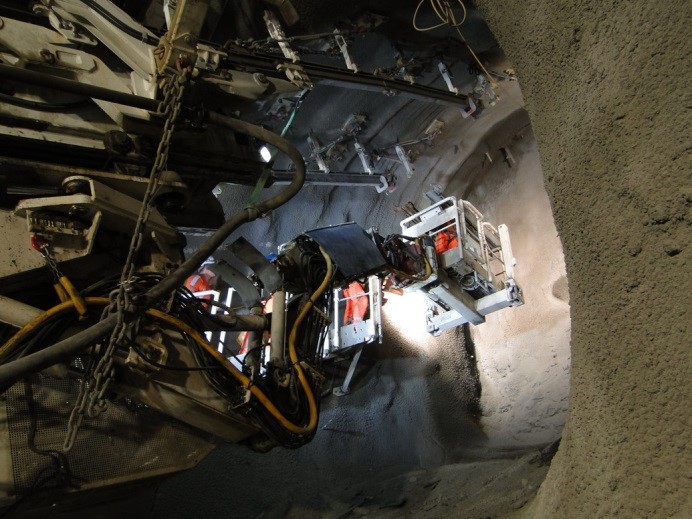
Uptake of apprenticeships
Around two in five (44%) Crossrail apprenticeships have been filled by people that were previously not in work; a figure that’s double the UK average.
Crossrail originally committed to delivering at least 400 apprenticeships over the lifetime of the project. In 2015 this commitment was realised when 400th apprentice joined the BBMV team.
Since 2011 BBMV have employed apprentices across a range of apprenticeship frameworks such as:
Business and Administration
Civil Engineering
Bricklaying
Plumbing
Association of Accounting Technician
Electrical Installation
BBMV employed apprentices in various different departments including health and safety, human resources, accounts, construction and document control.
These frameworks ranged from level 2 to level 3 and the individuals have been employed by JV parent companies as well as BBMVs supply chain including RJ Sheen, Fortel and VGC.
From project start to date, BBMV employed 16% of all the original target of 400 apprenticeships.
The apprentices have been trained in a range of professions from construction to accountancy, quantity surveying to business administration.
Apprentices were employed on full time contracts and guaranteed a job on completion of their framework, providing they complete the framework. Our JV Parent companies have sponsored individuals to go onto further education such as:
CIPD level 5
Quantity Surveying Degree’s
HNCs
HNDs
An apprentice mentoring scheme for the current business and administration apprentices was also setup, where ex apprentices meet with current apprentices to provide advice on the framework and to also give them advice on day to day work issues.
Award presentation
Chris Broadbent (Director, CEEQUAL) presented the award certificates to Mohamed El Shazley, Peter Leyton and Francesca Pacifico at the CEEQUAL regional meeting in London on 22 November 2017.
